Fly Patterns from the Evil Weevil
Hey! This is Jeremy. Out of over 100 recipes, why did I select these for you? I want to give you a little intro to the 10 flies selected. These 10 recipes have been selected because they are either:
- easy to tie, or
- unique in the way they are fished.
Flies such as the Arizona Dot and the Coachman Cheater utilize synthetic materials instead of natural materials either to make the fly easier to tie or make it more durable. The Antron Collared Bugger, Alive Worm, and the Damsel Weevil can be considered a step forward in making a fly look more lifelike. The Floating Weevil and the Thorax Caddis/PMD represent very versatile dry flies that can mimic several different insects available to trout. The Sloppy Stimmy and Jeremy's October Caddis Pupa are also versatile and not all that difficult to tie. The Sloppy Stimmy is unique as it is an attractor dry that can function as an effective streamer when pulled under the water. The Fusion Streamer is an effective beautiful fly and can be fished as a leech or fish imitation. I encourage you to practice and master all of these flies because most of them are not all that difficult to tie and catch fish! Good luck!!! What equipment is required to start fly tying? To get a good start in fly tying you should have the following:
- Fly tying Vice with base, Thread Bobbin, Whip Finisher
- 8/0 & 6/0 Uni-thread (Black, red, tan, and olive)
- Hooks- Standard Nymph and Dry fly, 3X Streamer hooks, scud hooks
- Beads- gold,black (5/64,3/32,7/64,1/8,5/32)
- Female ringneck pheasant skin, pheasant tail, goose biots (brown, black, white, olive), peacock herl
- Dubbing- antron for dries, natural for nymphs, Arizona dubbing
- Various synthetic material: Thin Skin, antron yarn (various colors)
- Saddle – Grizzly, brown, black, olive etc
An extremely interesting and unique worm pattern with a lot of built in life.
Very effective in small streams or creeks fished with a split shot or as part of a combo with a heavier fly such as stonefly nymph or Acetate Worm.
This fly has very few steps, but is a little tricky to tie at first. Put the red glass bead on first and then tie the marabou on either side next. The key to this pattern is the wine or red marabou as it undulates in the current like a real earthworm. Put a bit of head cement or other glue at the end of the marabou to create a tip.
Hook: Heavy wire scud hook
Thread: Red Uni-Thread 8/0
Body/Tail: Red or maroon marabou
Bead: Red Glass
Great streamer pattern in medium to large western trout streams, especially when weight is needed.
Best fished in black, purple, and olive to imitate leeches. White is great for mimicking minnows or small fish.
The cone and the .025 lead ensure this pattern sinks deep very quickly even in fast moving pools. The collar constructed of antron body fur is a great material for making this streamer visible in moving water. When using marabou for the tail in my streamers I only use woolly bugger style marabou from Wapsi or Hareline as it is much webbier and fluffier than standard blood quill marabou creating a more “juicy” or life- like fly.
Hook: 3X long streamer hook sizes 2-8
Thread:Red Uni-Thread 8/0
Head: Cone
Body: White ,black, olive or purple chenille
Throat: thread
Tail: White Marabou, Krystal Flash (optional)
Hackle: Grizzly or Black
Collar: Body Fur
Extremely simple and effective fly for imitating a small midge cluster.
Midges can be extremely tiny even down to size 28 which gives the fly angler very little chance of hooking and landing a large trout. Luckily during large midge hatches these insects will jumble up in to clusters of 2, 3 and even as many as 10. I tend to fish this fly in sizes 10 to 16 depending on the size of the clusters I see or the size of the hatch in general.
The Arizona Dot is meant to be fished floating high or in the film. When I finish tying this fly I tend to take about half of them and trim the hackle at the bottom to help it sit in the film. I generally use high quality saddle hackle such as Whiting even though they are scarce, but necks can also be used. A skilled or well practiced tier can tie as many as 30-35 an hour because you are just wrapping hackle and making a small dubbed dot in the middle.
Hook: Standard dry fly hook sz 10-16
Thread: Olive Uni-Thread 8/0
Body/dot: Arizona Dubbing- Natural Peacock
Hackle: Grizzly
1. Alive Worm
 An extremely interesting and unique worm pattern with a lot of built in life.
An extremely interesting and unique worm pattern with a lot of built in life.
Very effective in small streams or creeks fished with a split shot or as part of a combo with a heavier fly such as stonefly nymph or Acetate Worm.
This fly has very few steps, but is a little tricky to tie at first. Put the red glass bead on first and then tie the marabou on either side next. The key to this pattern is the wine or red marabou as it undulates in the current like a real earthworm. Put a bit of head cement or other glue at the end of the marabou to create a tip.
Hook: Heavy wire scud hook
Thread: Red Uni-Thread 8/0
Body/Tail: Red or maroon marabou
Bead: Red Glass
2. Antron Collar Bugger
 Great streamer pattern in medium to large western trout streams, especially when weight is needed.
Great streamer pattern in medium to large western trout streams, especially when weight is needed.
Best fished in black, purple, and olive to imitate leeches. White is great for mimicking minnows or small fish.
The cone and the .025 lead ensure this pattern sinks deep very quickly even in fast moving pools. The collar constructed of antron body fur is a great material for making this streamer visible in moving water. When using marabou for the tail in my streamers I only use woolly bugger style marabou from Wapsi or Hareline as it is much webbier and fluffier than standard blood quill marabou creating a more “juicy” or life- like fly.
Hook: 3X long streamer hook sizes 2-8
Thread: Red Uni-Thread 8/0
Head: Cone
Body: White ,black, olive or purple chenille
Throat: thread
Tail: White Marabou, Krystal Flash (optional)
Hackle: Grizzly or Black
Collar: Body Fur
3. Arizona Dot
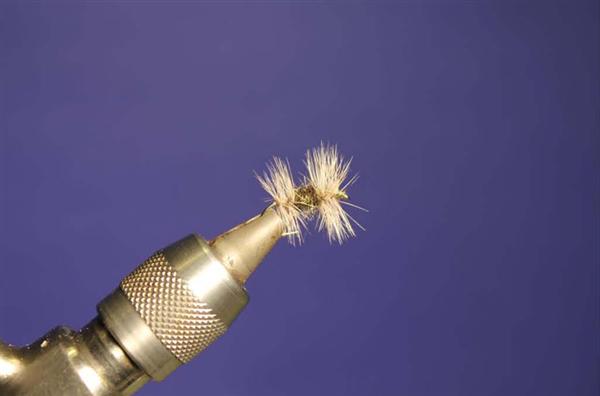 Extremely simple and effective fly for imitating a small midge cluster.
Extremely simple and effective fly for imitating a small midge cluster.
Midges can be extremely tiny even down to size 28 which gives the fly angler very little chance of hooking and landing a large trout. Luckily during large midge hatches these insects will jumble up in to clusters of 2, 3 and even as many as 10. I tend to fish this fly in sizes 10 to 16 depending on the size of the clusters I see or the size of the hatch in general.
The Arizona Dot is meant to be fished floating high or in the film. When I finish tying this fly I tend to take about half of them and trim the hackle at the bottom to help it sit in the film. I generally use high quality saddle hackle such as Whiting even though they are scarce, but necks can also be used. A skilled or well practiced tier can tie as many as 30-35 an hour because you are just wrapping hackle and making a small dubbed dot in the middle.
Hook: Standard dry fly hook sz 10-16
Thread: Olive Uni-Thread 8/0
Body/dot: Arizona Dubbing- Natural Peacock
Hackle: Grizzly
4. Coachman Cheater
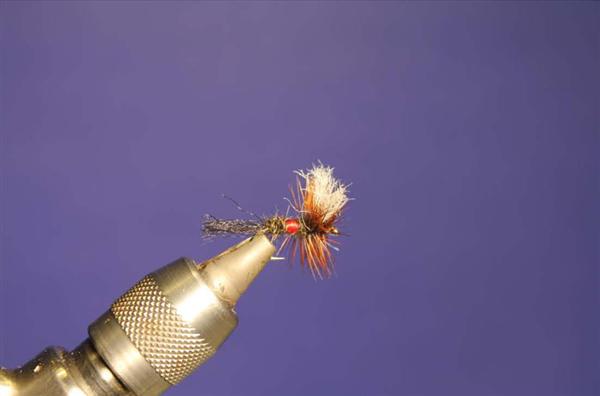 When fishing in the current or riffly water it is important to have a pattern that floats high and is easily seen.
When fishing in the current or riffly water it is important to have a pattern that floats high and is easily seen.
This easier- to-tie version of the Royal Coachman does this as well or better than the original. It is an attractor style pattern that generally suggests or mimics a larger mayfly or caddis.
One of the biggest challenges of tying the Royal Coachman is making even wings using calf tail or body hair. Why endure this hassle when you can make life alot easier by making the wing out of antron yarn.
Hook: Standard dry fly hook, sizes 10-16
Thread: Uni-thread 8/0 black
Body: Natural Peacock Arizona Dubbing and Red floss
Wings: White antron yarn
Hackle: Coachman Brown (Whiting is best)
Tail: Elk hair or antron yarn
5. Damsel Weevil
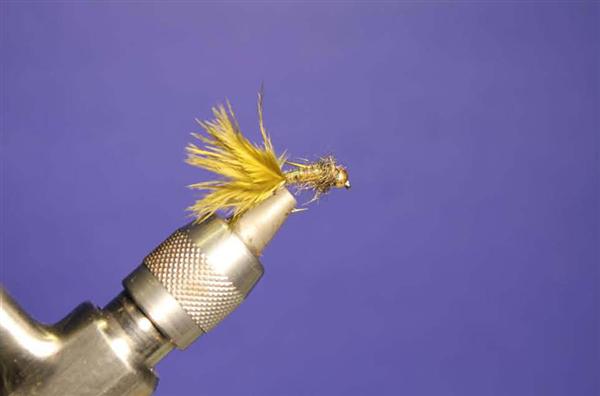 Used as a damsel and dragonfly specialist in lakes and beaverdams. Works well stripped in or left still under an indicator.
Used as a damsel and dragonfly specialist in lakes and beaverdams. Works well stripped in or left still under an indicator.
Tied in much the same way as the standard Evil Weevil, but with a large pulsing olive marabou tail and also in a larger size. Like with bugger patterns using wooley bugger marabou helps this fly create life.
Hook: Diiachi 1150/1120 or other scud hook, sizes 8-20
Thread: Olive Uni-thread 8/0
Head: Gold bead
Body: Light peacock Arizona Dubbing
Thorax : Natural peacock- Arizona Dubbing
Tail: Olive Wooley Bugger Marabou
Legs: Olive goose biots
Rib: Gold or copper wire
Shellback: Uni-Mylar pearl or Prismatic Pliable Sheet (Hareline) #10
6. Floating Weevil
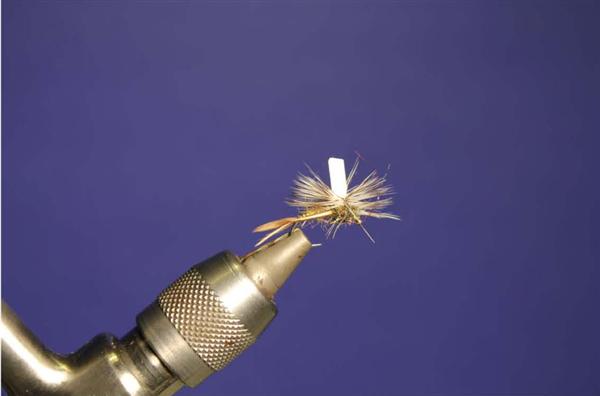 A great searching parachute dry that is easy to see.
A great searching parachute dry that is easy to see.
This pattern is very effective when mayfly and caddis are hatching and you are not certain on the type.
This fly is tied in much the same way as the Evil Weevil just without a gold bead and with grizzly saddle or neck hackle. I also tie this dry fly version with a light wire scud hook to help make it lighter to aid in buoyancy. I use a strip of white craft foam for the post to make this great parachute easier to see. Try using it on flat or slightly choppy water.
Hook: Diiachi 1130, sizes 10-18
Thread: Olive Uni-Thread 8/0
Post: White Foam
Tail: Female Ringneck Pheasant or black antron yarn
Body: Arizona Dubbing- Light Peacock
Thorax: Arizona Dubbing- Natural Peacock
Hackle: Grizzly
Legs: Brown goose biots
Rib: Extra fine gold wire or black thread
7. Fusion Streamer
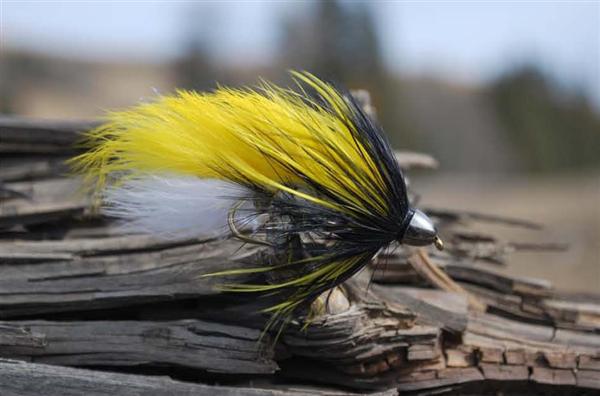 A beautiful and very lifelike streamer pattern that looks just as great to big trout as it does in your flybox or wall display.
A beautiful and very lifelike streamer pattern that looks just as great to big trout as it does in your flybox or wall display.
This very colourful fly is very visible in murky water conditions and entices many follows and strikes.
This fly is actually a cross between a Woolly Bugger and a Zonker tied in the official colors of Fly Fusion Magazine. The tail is made of white woolly bugger marabou that can be accompanied with or without flash. The body is made of white chenille with black hackle through it like a typical bugger pattern. There is a yellow rabbit strip tied over top like a Zonker with yellow and black soft hackle tied behind the cone. This fly is so pretty you may not want to fish it.
Hook: 3X long streamer hook
Weight: 0.025 lead
Head: Gold or nickel cone
Body: White chenille with black hackle wrapped through
Collar: Black and yellow hackle
Overwing: Yellow rabbit strips
Tail: White marabou
Rib: Gold or copper wire
8. Jeremy’s October Caddis Pupa
 A very effective imitation for the fall emerging extra large Caddis nymph. Looks very lifelike and is best fished deep near the bottom from late August to October in great western rivers like the Bow River in the Calgary area.
A very effective imitation for the fall emerging extra large Caddis nymph. Looks very lifelike and is best fished deep near the bottom from late August to October in great western rivers like the Bow River in the Calgary area.
This fly can also be used as a golden stonefly imitation.
Since this fly needs to be fished fairly deep it is often a good idea to cover half the hook shank with lead and/or a tungsten bead. The key to this fly is to create a sleek tapered segmented body with a bushy, well picked out thorax.
Hook: Stimulator hook sz 8-12
Thread: Black or Olive Uni-Thread 8/0
Bead: Black or gold (reg or tungsten)
Body: golden or light orange dubbing, lead (optional)
Legs: pheasant tail fibers and Krystal Flash
Thorax: Golden orange Simi-Seal Dubbing
Rib: Copper wire
9. Sloppy Stimmy
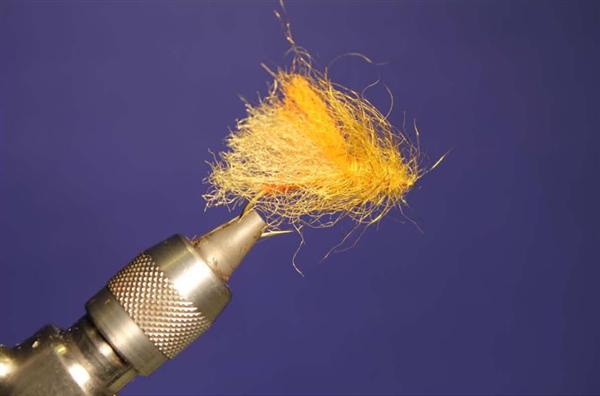 This emerging style attractor is more than just a dry fly; it can also double as a streamer. Trout find an insect that is drowning in the surface film irresistible.
This emerging style attractor is more than just a dry fly; it can also double as a streamer. Trout find an insect that is drowning in the surface film irresistible.
Fish this fly with a light amount of floatant and grease the leader. If you are not getting violent rises try pulling it under by stripping it in.
Unlike the regular Stimulator this fly does not require any hackle which is quite appealing as saddle hackle is very scarce at the present time. It is also easier to make a wing and tail out of antron yarn than elk or deer hair. The only part of this fly that might pose an issue for some tiers is the thorax that requires dubbing Simi-Seal Dubbing. The secret is to be gentle and loosely dub and pick it out to flare it out.
Hook: Stimulator hook sz 6- 14
Thread: Red Uni-Thread 8/0
Body: Orange antron dubbing
Thorax: Golden olive Simi Seal Dub
Wing: Amber MFC Widows Web
Indicator: Florescent Orange Antron yarn
Rib: Extra fine gold wire (Lagartun)
Tail: Amber MFC Widow’s Web
10. Thorax Caddis /PMD
 A versatile little fly that can be used to imitate both a caddis and a PMD mayfly.
A versatile little fly that can be used to imitate both a caddis and a PMD mayfly.
This is an absolutely deadly fly to use throughout the summer when mayflies and caddis are hatching everywhere. It floats high and dry.
The elk hair wing mimics both the tent shape of a caddis and the silhouette of a mayfly wing. The light wire scud hook makes the fly light and the wide gap helps keep large trout hooked longer. The antron yarn tail either represents a tail for a PMD or a trailing shuck from a caddis.
Hook: Diiachi 1130 sizes 10-20
Thread: Uni-Thread 8/0 Olive
Body: Olive or tan antron dubbing
Wing: Deer or Elk Hair
Hackle: Grizzly
Tail: Olive antron yarn
Rib: Extra-fine gold wire or black thread
Spread the word! http://new.theevilweevil.com
Come share with us: https://theevilweevil.com/blog/
Come hang with us: http://www.facebook.com/theevilweevil
